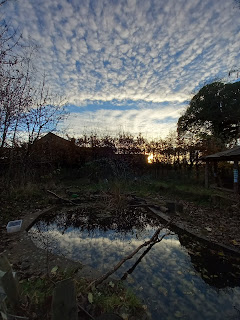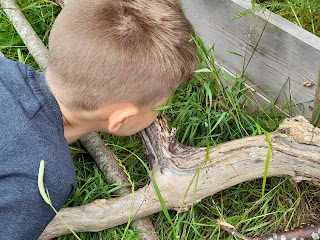The End of Summer (Part 2)
Well, the British weather has done it again. It's waited until the school summer holidays ended before blooming into a heatwave!
It's been a challenging return to timetable. The heat hasn't entirely been through direct sunshine, most mornings have been misty and ethereal, and the afternoons hazy, but the humidity...
Ugh!
Even beneath the trees there has been little respite, and when the sun does break through, the temperature inches up a few degrees more!
When I first started working in Kent I was surprised how few of the children experienced their local environment away from school. We're based in a semi rural area and are surrounded by farmland. There are sheep at the bottom of the street, fields all around, woodland nearby, and a river coursing through.
Like Scilly children, our pupils have access to hedgerows and trees, grasses and crops, rivers and (a bus ride away) the sea. But not as many of them explore it.
The safety of the Scilly Isles lies in its community. Everyone watches out for everyone else. Anyone doing wrong is trapped on the islands and has to face the consequences! Whilst nowhere can be 100% safe, these island communities come pretty close to it. It may not take a village to raise a child, but there it seems to take an island!
For us the community isn't the same. Once upon a time it certainly was, but times change. Villages are sprawling into towns, expanding at significant rates. New housing brings in new families, new friends, and a much more cosmopolitan feel to life. People can live here and work elsewhere. Neighbours may not know all the children in the street, nor who their aunts, uncles, and cousins are! There is the possibility of anonymity which many embrace in many places on the mmainlad.
Neither place is the 'right' place to live, each has it's pros and cons.
Having worked in a city I assumed the pupils at school would know more about the countryside around us than I did. And some do. But many were not born here, or their families are not from here, and don't have the knowledge to pass on.
Modern life also means between housework and going to work parents have limited time to spend with their children outdoors.
Forest School for us, is mostly about giving children the space and permission to explore. To be amongst trees. To get muddy. To recognise the Sycamore tree. To avoid the brambles!
The children enjoy seeing birds and bugs and rarely take them for granted. They are eager to share what they find, to take an adult to see the discovery too, to care for creatures, to find out more.
Frequently, activities are abandoned, equipment unused, the opportunity to explore, to investigate, and to discover, coupled with the freedom to just be, almost visibly recharges their batteries.
In Part 1 I said how it's almost the reverse in the Scillys, there children like to utilise tools to enhance their Forest School sessions. In my day to day practice I find my children are happy to just embrace the space.
That's not to say they never undertake an activity, or create one of their own. They bring prior knowledge and are quick to take on board new information.
But what they really like is just having the sense of freedom that unstructured play allows.
Sometimes I find them just sitting with their eyes closed, face to the sun, charging up on vitamin D like human solar panels! Or looking for crickets, listening and following the sound.
Others like to climb up and sit in a tree, and just hang out there.
Providing the resources to answer questions that may come up is part of Forest School. Allowing what the children do to be child led can be a challenge, but it's worth it.
Discoveries they make and see through to an understanding is the highest level of learning, and year 6 remember such things from year 2!
It's how children learn to learn.
It's not just why I love Forest School, it's why I deliver Forest School!











Comments
Post a Comment